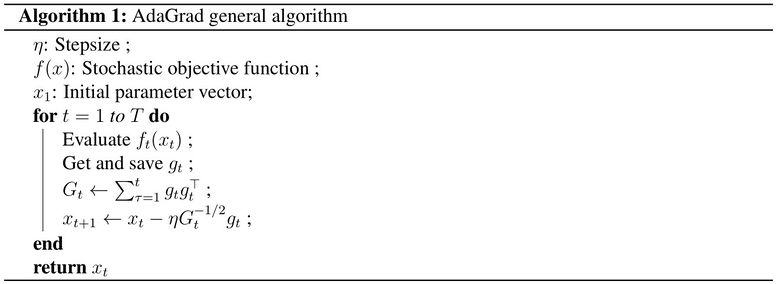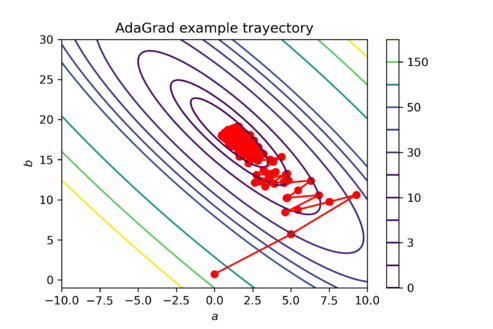AdaGrad: Difference between revisions
| Line 93: | Line 93: | ||
=== Comparison with Other Gradient-based Methods === | === Comparison with Other Gradient-based Methods === | ||
AdaGrad is an improved version of regular SGD, it includes second-order information in the parameter updates and provides adaptative learning rates for each parameter. However, it doesn't incorporate momentum, which could improve convergence rates. | |||
==== Stochastic Gradient Descent (SGD) ==== | ==== Stochastic Gradient Descent (SGD) ==== | ||
Revision as of 18:55, 14 December 2021
Author: Daniel Villarraga (SYSEN 6800 Fall 2021)
Introduction
AdaGrad is a family of sub-gradient algorithms for stochastic optimization. The algorithms belonging to that family are similar to second-order stochastic gradient descend with an approximation for the Hessian of the optimized function. AdaGrad's name comes from Adaptative Gradient. Intuitively, it adapts the learning rate for each feature depending on the estimated geometry of the problem; particularly, it tends to assign higher learning rates to infrequent features, which ensures that the parameter updates rely less on frequency and more on relevance.
AdaGrad was introduced by Duchi et al.[1] in a highly cited paper published in the Journal of machine learning research in 2011. It is arguably one of the most popular algorithms for machine learning (particularly for training deep neural networks) and it influenced the development of the Adam algorithm[2].
Theory
The objective of AdaGrad is to minimize the expected value of a stochastic objective function, with respect to a set of parameters, given a sequence of realizations of the function. As with other sub-gradient-based methods, it achieves so by updating the parameters in the opposite direction of the sub-gradients. While standard sub-gradient methods use update rules with step-sizes that ignore the information from the past observations, AdaGrad adapts the learning rate for each parameter individually using the sequence of gradient estimates.
Definitions
: Stochastic objective function with parameters .
: Realization of stochastic objective at time step . For simplicity .
: The gradient of with respect to , formally . For simplicity, .
: Parameters at time step .
: The outer product of all previous subgradients, given by
Standard Sub-gradient Update
Standard sub-gradient algorithms update parameters according to the following rule:
AdaGrad Update Rule
The general AdaGrad update rule is given by:
Adaptative Learning Rate Effect
An estimate for the uncentered second moment of the objective function's gradient is given by the following expression:
which is similar to the definition of matrix , used in AdaGrad's update rule. Noting that, AdaGrad adapts the learning rate for each parameter proportionally to the inverse of the gradient's variance for every parameter. This leads to the main advantages of AdaGrad:
- Parameters associated with low frequency features tend to have larger learning rates than parameters associated with high frequency features.
- Step-sizes in directions with high gradient variance are lower than the step-sizes in directions with low gradient variance. Geometrically, the step-sizes tend to decrease proportionally to the curvature of the stochastic objective function.
which favor the convergence rate of the algorithm.
Algorithm
The general version of the AdaGrad algorithm is presented in the pseudocode below. The update step within the for loop can be modified with the version that uses the diagonal of .

Variants
One main disadvantage of AdaGrad is that it can be sensitive to the initial conditions of the parameters; for instance, if the initial gradients are large, the learning rates will be low for the remaining training. Additionally, the unweighted accumulation of gradients in happens from the beginning of training, so after some training steps, the learning rate could approach zero without arriving at good local optima [3]. Therefore, even with adaptative learning rates for each parameter, AdaGrad can be sensitive to the choice of global learning rate . Some variants of AdaGrad have been proposed in the literature [3] [4] to overcome this and other problems, arguably the most popular one is AdaDelta.
AdaDelta
AdaDelta is an algorithm based on AdaGrad that tackles the disadvantages mentioned before. Instead of accummulating the gradient in over all time from to , AdaDelta takes an exponential weighted average of the following form:
where is an hyperparameter, known as the decay rate, that controls the importance given to past observations of the squared gradient. Therefore, in contrast with AdaGrad, with AdaDelta the increase on is under control. Typicall choices for the decay rate are 0.95 or 0.90, which are the default choices for the AdaDelta optimizer in TensorFlow[5] and PyTorch[6], respectively.
Additionally, in AdaDelta the squared updates are accumulated with a running average with parameter [3]:
where,
so the update rule in AdaDelta is given by:
RMSprop
RMSprop is identical to AdaDelta without the running average for the parameter updates. Therefore, the update rule for this algorithm is the same as AdaGrad with calculated as done for AdaDelta ()[7].
Regret Bound
The regret is defined as:
where is the set of optimal parameters. AdaGrad has a regret bound of order , which leads to the convergence rate of order , and the convergence guarantee (). The detailed proof and assumptions for this bound can be found in the original journal paper[1]. However, with some modifications to the original AdaGrad algorithm, SC-AdaGrad[4] shows a logarithmic regret bound ().
Considering the dimension of the gradient vectors, AdaGrad has a regret bound of order . Nevertheless, for the special case when gradient vectors are sparse, AdaGrad has a regret of an order [1]. Therefore, when gradient vectors are sparse, AdaGrad's regret bound can be exponentially better than SGD (which has a regret bound equal to in that setting).
Comparison with Other Gradient-based Methods
AdaGrad is an improved version of regular SGD, it includes second-order information in the parameter updates and provides adaptative learning rates for each parameter. However, it doesn't incorporate momentum, which could improve convergence rates.
Stochastic Gradient Descent (SGD)
SGD's update rule is fairly simple:
Adam
Numerical Example

To illustrate how the parameter updates work in AdaGrad take the following numerical example. The dataset consists of random generated obsevations that follow the linear relationship:
| 0.39 | 9.83 |
| 0.10 | 2.27 |
| 0.30 | 5.10 |
| 0.35 | 6.32 |
| 0.85 | 15.50 |
The cost function is defined as . And an observation of the cost function at time step is given by , where are sampled from the obsevations. Finally, the subgradient is determined by:
Take a learning rate , initial parameters , and . For the first iteration of AdaGrad the subgradient is equal to:
and is:
Applications
The AdaGrad family of algorithms is typically used in machine learning applications. Mainly, it is a good choice for deep learning models with sparse input features[1]. However, it can be applied to any optimization problem with a differentiable cost function. Given its popularity and proven performance, different versions of AdaGrad are implemented in the leading deep learning frameworks like TensorFlow and PyTorch. Nevertheless, in practice, AdaGrad tends to be substituted by the use of the Adam algorithm; since, for a given choice of hyperparameters, Adam is equivalent to AdaGrad [2].
Conclusion
AdaGrad is a family of algorithms for stochastic optimization that uses a Hessian approximation of the cost function for the update rule. It uses that information to adapt different learning rates for the parameters associated with each feature. Their main two advantages are that: it assigns more significant learning rates to parameters related to low-frequency features, and the updates in directions of high curvature tend to be lower than those in low-curvature directions. Therefore, it works especially well for problems where the input features are sparse. AdaGrad is reasonably popular in the machine learning community, and it is implemented in the primary deep learning frameworks. In practice, the Adam algorithm is usually preferred over AdaGrad since, for a given choice of hyperparameters, Adam is equivalent to AdaGrad.
References
- ↑ 1.0 1.1 1.2 1.3 Duchi, J., Hazan, E., & Singer, Y. (2011). Adaptive subgradient methods for online learning and stochastic optimization. Journal of machine learning research, 12(7).
- ↑ 2.0 2.1 Kingma, D. P., & Ba, J. (2014). Adam: A method for stochastic optimization. arXiv preprint arXiv:1412.6980.
- ↑ 3.0 3.1 3.2 Zeiler, M. D. (2012). Adadelta: an adaptive learning rate method. arXiv preprint arXiv:1212.5701.
- ↑ 4.0 4.1 Mukkamala, M. C., & Hein, M. (2017, July). Variants of rmsprop and adagrad with logarithmic regret bounds. In International Conference on Machine Learning (pp. 2545-2553). PMLR.
- ↑ tf.keras.optimizers.Adadelta | TensorFlow Core v2.7.0. (2021). Tf.Keras.Optimizers.Adadelta. https://www.tensorflow.org/api_docs/python/tf/keras/optimizers/Adadelta
- ↑ Adadelta — PyTorch 1.10.0 documentation. (2019). ADADELTA. https://pytorch.org/docs/stable/generated/torch.optim.Adadelta.html
- ↑ Hinton, G. E. Neural Networks for Machine Learning: Lecture 6a Overview of mini-batch gradient descent. http://www.cs.toronto.edu/~tijmen/csc321/slides/lecture_slides_lec6.pdf






























![{\displaystyle E[\Delta x^{2}]_{t}=\rho E[\Delta x^{2}]_{t-1}+(1-\rho )\Delta x_{t}^{2}}](https://wikimedia.org/api/rest_v1/media/math/render/svg/35358ea55a37e1c6780d5f60c69521eaf543e2fa)














![{\textstyle f(a,b)={\frac {1}{N}}\sum _{i=1}^{n}([a+b\cdot x_{i}]-y_{i})^{2}}](https://wikimedia.org/api/rest_v1/media/math/render/svg/d86302234845f28e7123709faaa4cd93d7260f9d)
![{\displaystyle f_{t}(a,b)=([a+b\cdot x_{t}]-y_{t})^{2}}](https://wikimedia.org/api/rest_v1/media/math/render/svg/6907c9197706539cecb74f1c2b7c4266b99690b1)

![{\displaystyle g_{t}={\begin{bmatrix}2([a_{t}+b_{t}\cdot x_{t}]-y_{t})\\2x_{t}([a_{t}+b_{t}\cdot x_{t}]-y_{t})\end{bmatrix}}}](https://wikimedia.org/api/rest_v1/media/math/render/svg/e1b916a0cb18358a5697db2b4839a506fb886d26)



![{\displaystyle g_{1}={\begin{bmatrix}2([0+0\cdot 0.39]-9.84)\\2\cdot 0.39([0+0\cdot 0.39]-9.84)\end{bmatrix}}={\begin{bmatrix}-19.68\\-7.68\end{bmatrix}}}](https://wikimedia.org/api/rest_v1/media/math/render/svg/f11843be8e8b85c9825f07d0c693a1927eb82c2b)



